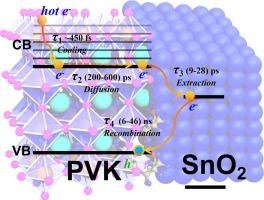高效稳定钙钛矿太阳能电池的CsHFDF双功能极性分子辅助协同钝化
IF 13.2
1区 工程技术
Q1 ENGINEERING, CHEMICAL
引用次数: 0
摘要
尽管卤化铅钙钛矿以其独特的性能取得了令人瞩目的光伏性能,但其固有的深层缺陷和晶体缺陷仍然对太阳能器件的效率和稳定性产生关键影响。本研究将1,1,2,2,3,3-六氟丙烷-1,3-二磺酰亚胺铯盐(CsHFDF)加入到钙钛矿前驱体中,协同钝化缺陷,提高结晶质量。研究发现,CsHFDF抑制了碘化铅的结晶,从而调节了钙钛矿薄膜的结晶取向和生长。在晶界处锚定的HFDF¯具有双功能特性,可以有效地减少FA+和Pb2+欠配位缺陷,同时加入Cs+可以提高晶体的稳定性。利用瞬态吸收(TA)和时间分辨光致发光光谱在分子水平上系统地研究了光物理过程。CsHFDF的加入增强了钙钛矿内部的载流子体扩散和钙钛矿/SnO2界面的界面转移,同时减少了SnO2与钙钛矿之间的电荷复合。这些效应与CsHFDF掺杂后钙钛矿晶体数量和深层缺陷的协同调节密切相关。最终,基于这种极性分子掺杂的钙钛矿太阳能电池实现了小面积器件的功率转换效率为24.52 %,大面积(5 cm × 5 cm)钙钛矿太阳能组件的功率转换效率为21.02 %。本文章由计算机程序翻译,如有差异,请以英文原文为准。

CsHFDF bifunctional polar molecule-assisted synergistic passivation for highly efficient and stable perovskite solar cells
Even though lead halide perovskites have achieved impressive photovoltaic performance for their unique properties, inherent deep-level defects and crystal defects still show pivotal impact on efficiency and stability of solar devices. In this research, 1,1,2,2,3,3-Hexafluoropropane-1,3-disulfonimide caesium salt (CsHFDF) is incorporated into the perovskite precursor to synergistically passivate defects and enhance the quality of crystallization. It is found that CsHFDF inhibits the crystallization of lead iodide, which in turn modulates the crystal orientation and growth of the perovskite film. The HFDF¯ anchored at grain boundaries exhibits bifunctional characteristics, effectively reducing undercoordinated FA+ and Pb2+ defects, meanwhile the incorporated Cs+ can enhance the crystal stability. The transient absorption (TA) and time-resolved photoluminescence spectroscopy are utilized to systematically investigate the photophysical processes at the molecular level. The addition of CsHFDF enhanced both carrier bulk diffusion within the perovskite and interfacial transfer at the perovskite/SnO2 interface, while simultaneously reducing charge recombination from SnO2 to perovskite. These effects are closely related to the synergistic regulation of perovskite crystal quantity and deep-level defects after CsHFDF doping. Ultimately, perovskite solar cells based on this polar molecule doping achieved a power conversion efficiency of 24.52 % for small-area devices and 21.02 % for large-area (5 cm × 5 cm) perovskite solar modules.
求助全文
通过发布文献求助,成功后即可免费获取论文全文。
去求助
来源期刊

Chemical Engineering Journal
工程技术-工程:化工
CiteScore
21.70
自引率
9.30%
发文量
6781
审稿时长
2.4 months
期刊介绍:
The Chemical Engineering Journal is an international research journal that invites contributions of original and novel fundamental research. It aims to provide an international platform for presenting original fundamental research, interpretative reviews, and discussions on new developments in chemical engineering. The journal welcomes papers that describe novel theory and its practical application, as well as those that demonstrate the transfer of techniques from other disciplines. It also welcomes reports on carefully conducted experimental work that is soundly interpreted. The main focus of the journal is on original and rigorous research results that have broad significance. The Catalysis section within the Chemical Engineering Journal focuses specifically on Experimental and Theoretical studies in the fields of heterogeneous catalysis, molecular catalysis, and biocatalysis. These studies have industrial impact on various sectors such as chemicals, energy, materials, foods, healthcare, and environmental protection.
 求助内容:
求助内容: 应助结果提醒方式:
应助结果提醒方式:


